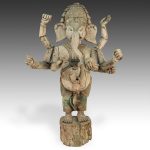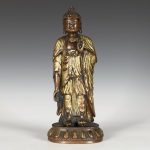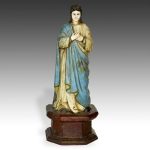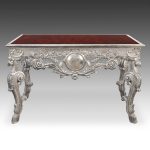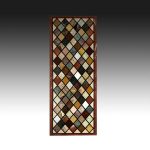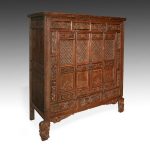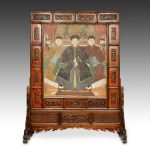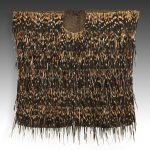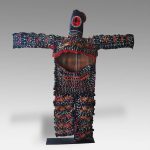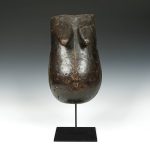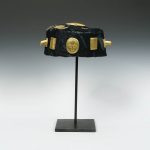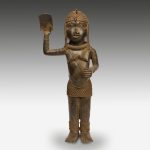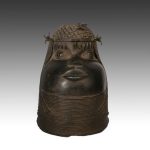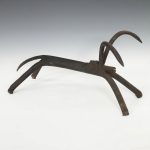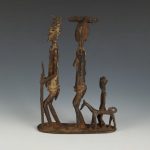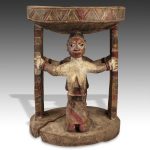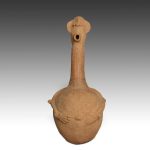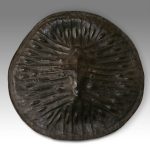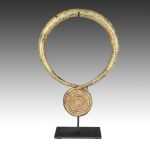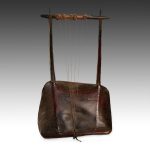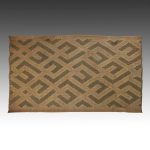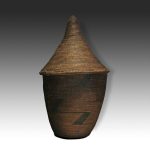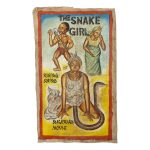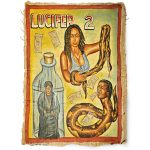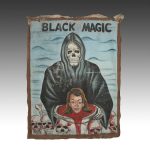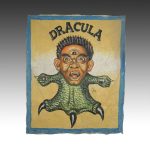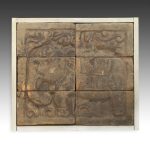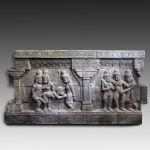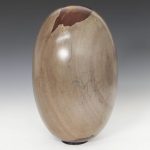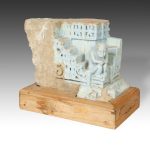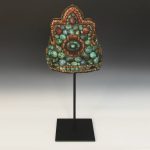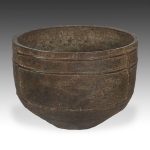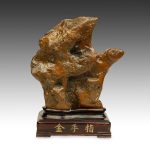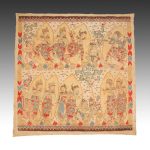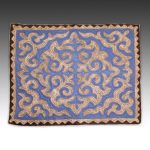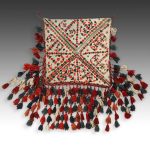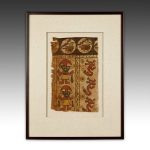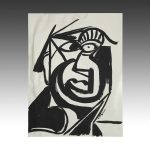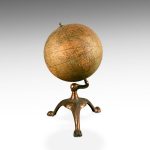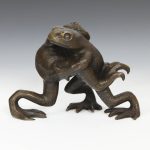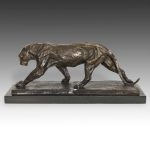Ancient, Folk, Ethnographic Art and Furnishings from the Collection of PRIMITIVE, Chicago
Online* Auction: Sunday, August 7, 2016, 11AM EST
Chicago Exhibition: August 5-6, 11AM-5PM
*Also Accepting Phone and Absentee Bids
PLEASE NOTE: All auction items are located in CHICAGO
for preview and pick up at 130 N. Jefferson St., Chicago, IL 60661.
Browse the Auction Catalog and Bid Live on these Portals:
Absentee Bid Form | Telephone Bid Form | Terms and Conditions (PDF)
On August 7, 2016, Material Culture will conduct an auction of 555 items from the collection of Chicago-based gallery and world antique store PRIMITIVE. PRIMITIVE began as a purveyor of African art, but now its immersive museum-like showrooms carry items from all over the world, ranging from the ancient to the modern. The auction brings to the international market an array of the kinds of decorative and ethnographic arts and hand-crafted furnishings for which Primitive has become well-known. Pieces from Africa form a strong spine for the sale, with exceptional showings in sculpture, textile, painting, ceramic, rugs and more. All of these categories are also represented in Asian art, with treasures from China, India, Indonesia, Laos, Burma, Vietnam, Thailand, Korea, Japan, Tibet, Nepal, Afghanistan, Turkmenistan, Uzbekistan, Turkey, and Iran. Painting and prints from the United States and Mexico, textiles from Peru, Bolivia, and Guatemala, and home décor from Holland, Belgium, Germany and England round out the auction.
Two monumental statues might be said to stand at the head of the sale. From China, an immaculate lacquered-wood Buddha of gleaming black and gold measures 63 inches high, including the lotus base on which he sits (lot 309). Dating to the late 19th or early 20th century, the sculpture’s intricate detailing in gold paint is a counterpoint to its imposing size. The auction’s Indian answer to this statue is an eight-foot (98”) tall 19th century Ganesh, the fine detail on his headdress and adornments rendered in delicate carving. Its wood bears evidence that it was once painted, though it has since faded, and the seams of the wooden pieces used to make such a large piece are visible, giving this piece an otherworldly charm (lot 271). Another figural piece from India, representing a different culture within the country’s borders, is a maternity figure made by the Khond people, one of India’s oldest tribes. The patinated brass woman holds a baby and sits upon a stool, and measures a sizeable 31 inches high (lot 302). Two smaller antique statues from China are also worthy of note—a 19th century seated figure of Quan Yin is rendered in painted bronze (lot 167), while a bronze Buddha standing on a lotus base, dating to the late 19th or early 20th century, has gilding on his robe (lot 311). Also deserving a mention in this category are four 19th century French Colonial religious figures of carved and painted wood from Vietnam, depicting the Virgin Mary, St. Dominic, and St. Vincent Ferrer (lots 389-392).
- Lot 309.
- Lot 271.
- Lot 302.
- Lot 311.
- Lot 389.
Some outstanding furnishings from India and China also provide highlights. Several contemporary pieces from Rajasthan, India, are led by a spectacular Rococo style writing table of carved teak wood clad in silver repousse, with a pietra dura top of inlaid jasper in a herringbone pattern (lot 409). A separate pietra dura table top uses a variety of polished stone of varying color and geological pattern in a repeating diamond motif (lot 429). From China, an impressive 19th century cabinet of elm wood bears a façade almost entirely covered with ornate carvings, human and animal figures tucked into its geometric and floral designs (lot 350). Even more spectacular is a rare floor screen from Shanxi Province, also of elm wood, dating to the late 18th or early 19th centuries. Finely carved with dragons and other intricate designs, the lacquered wood forms a free-standing frame for a painted portrait of an ancestor group (lot 310).
- Lot 409.
- Lot 429.
- Lot 350.
- Lot 310.
One of the most exceptional pieces in the entire sale, leading its wealth of African art, is a dramatic ceremonial tunic entirely covered in porcupine quills, front and back, attached to a woven fiber base. Made by the Kaka people of Cameroon, these tunics are not only breathtaking but extremely rare due to their use in active religious ceremonies. The tunics are worn by members of a society of elders in trance dances that invite spiritual possession to solve problems or commemorate events, and the quills are meant to protect the wearer from any malevolent spirits that might try to intrude (lot 3). This tunic is only one of many excellent African pieces in the auction that were made to be worn; another exceptionally rare dance garment is a Agbogho Mmuo or Maiden Spirit costume, made by the Igbo or Ibibio people of Nigeria. This full-body costume is worn by grown men in a masquerade in which they portray young women in an exaggerated display of their feminine grace, and the brightly-colored appliqued cloth of the costume mimics the patterns of traditional body paintings (lot 1). The Makonde people of Tanzania, on the other hand, perform dances in which an adolescent man represents a pregnant woman as an act of initiation, wearing a body mask with breasts and a swollen belly. The Makonde body mask at auction is extremely unusual for its petite size—only thirteen inches high and eight inches wide (lot 19). A more straightforward piece of apparel is a beautiful velvet hat with ornaments leafed in high-karat gold, made to be worn by a Chief of the Baule people of the Ivory Coast (lot 13).
- Lot 3.
- Lot 1.
- Lot 19.
- Lot 13.
Of the excellent showing of traditional African sculpture in the auction, the finest lot is arguably a superb Benin bronze female court attendant. She stands at 27.25 inches high, holding aloft a decree, with fine detail in her hair and attire (lot 4). Also from Benin is a splendid commemorative head of a queen, made of cast brass and dating to the late 19th or early 20th centuries (lot 21). Other notable sculptures include an iron bull made by the Haya people of Tanzania (lot 206), a family procession of mother, father, child and dog, rendered in bronze by Mali’s Dogon people (lot 208), and, from the Lobi people of Burkina Faso, a bronze maternity figure cradling her baby while her husband places a protective arm on her shoulder. Figural elements are also incorporated into a number of utile pieces in the sale, seen in a ceremonial stool made by the Yoruba people of Nigeria in which the seat is braced by a pair of male and female figures (lot 47), and an anthropomorphic kwandalowa or initiate, a ritual healing vessel made of terra cotta by the Longuda or Cham people, also of Nigeria, which dates to the 19th century (lot 88).
- Lot 4.
- Lot 21.
- Lot 206.
- Lot 208.
- Lot 47.
- Lot 88.
Many of the sale’s pieces of ethnographic art from Africa are items created for function as well as form. An impressive war shield with a spurred surface of buffalo hide comes from the Sidamo or Oromo people of Ethiopia, and dates a pair of centuries back to the early 19th century (lot 26). Several intriguing lots of items used for currency are led by an extremely rare piece in bronze from the Central African Republic. Presented at auction on a stand, it was originally made to be worn around the neck, the sides winding into a spiral medallion (lot 161). Two rare iron currency pieces come from Nigeria: one, from the Yoruba people, takes the shape of a double gong, and the other, from the Mumuye or Chamba people, abstractly represents the confrontation between two antelopes. From Ethiopia, a five-stringed lyre called a dita, made of leather and wood, also resembles an antelope (lot 35). Woven items includes a series of rare Kuba mats, highly prized by collectors, made of raffia and bamboo by the Kuba people of the Republic of Congo (lots 223-227), and an agaseke or ibeseke basket with a conical lid made by the Tutsi people. The Tutsi are considered some of the finest basket weavers in the world, and baskets such as this one, from the early 20th century, are increasingly rare due to the tumult in their home country of Rwanda (lot 57).
- Lot 26.
- Lot 161.
- Lot 35.
- Lot 223.
- Lot 57.
The majority of African painting in the auction consists of over forty lots of authentic hand-painted movie posters from Ghana. Itinerant cinemas, consisting of an entrepreneur with a projector or television and a portable generator, began to travel between villages in the late 1980s, and these spectacular canvases arose from a need to advertise the film on offer. Sometimes the posters assemble a few images to entice viewers, as seen in posters at auction for “The Snake Girl” (lot 251) and “Lucifer 2” (lot 253), and other times a single image does the trick, as with the grim reaper serving up the smiling head of a woman on a plate for “Black Magic” (lot 260), or the mystifying image of a three-eyed and fanged man with a monstrous claw for a body that advertises “Dracula” (lot 246).
- Lot 251.
- Lot 253.
- Lot 260.
- Lot 246.
Travelling back to Asia for a look at some of the sale’s other highlights brings us first to Indonesia, with two very different relief panels. From the Majapahit Empire that ruled on the island of Java from 1293 to approximately 1500, the first relief panel depicts a formidable elephant on six terra cotta blocks, now framed (lot 274). The much larger relief, spanning nearly eight feet across, shows a foursome and a threesome engaged in erotic activities; the lava stone carving, in excellent condition, does not have a verified age (lot 273).
- Lot 274.
- Lot 273.
Some additional pieces in stone from India also deserve mention, such as a 19th century Tantric offering water spout made of Jaisalmer stone in Jaipur, Rajasthan (lot 272), and a Tantric lingam, a polished stone found in the Narmada River that represents the union of male and female energy and serves as an important tool for Tantric healears (lot 279). From a temple devoted to the Jain religion, a fragment in carved and painted stone shows a monkey sitting pensively at its corner; the piece, dating to the 18th century or earlier and traced to the Kutch district of western India, has been fitted to a wooden base for display (lot 277). A ceremonial crown, set entirely in polished semi-precious stones including turquoise, carnelian, agate, and mother of pearl, is a splendid example of the ornamentation traditional to the Ladakh people of northern India (lot 323). Other notable Chinese pieces include a series of iron temple gongs from Pingyao, in the Shan Xi province, that date to the 16th-18th centuries (lots 304-308), and a yellow wax stone gongshi, or scholar’s stone, from the Guangdong province (lot 334).
- Lot 272.
- Lot 279.
- Lot 277.
- Lot 323.
- Lot 304.
- Lot 334.
Textiles and rugs come to the auction from all over the globe. A rare Tibetan thangka dating to the late 18th or early 19th centuries renders a familiar depiction of Shakyamuni Buddha flanked by two bodhisattvas in an unusual style (lot 318). The Klungkung Regency of Bali is famous for its story paintings depicting scenes from Hindu mythology, and the auction includes a fine example of a tabing story cloth dating to the early 20th century. With pigment on cotton, this tabing illustrates action in the Arjunawiwaha, in which the hero Arjuna is tempted to stray from his meditation (lot 269). Two noteworthy pieces in felt from Central Asia are a shyrdak felt rug from Kyrgyzstan (lot 468) and a tassled Koran bag, made with camel felt, from early 20th century Turkmenistan (lot 469). From a series of pre-Columbian textiles, one tunic fragment from the Chancay culture (1100-1450 CE) particularly stands out. Framed to protect its centuries of age, the textile is painted with delightful human figures, parrots, and another dragon-like animal (lot 6).
- Lot 318.
- Lot 269.
- Lot 468.
- Lot 469.
- Lot 6.
Other compelling findings in the sale include twenty paintings by Illinois artist George Colin (1929-2014), a self-taught artist whose early works were created on rolls of printing paper from printing plants near to the Pillsbury factory where he sacked flour. As he continued to paint, he moved to artist’s paper for his work, and most of the pieces at auction are on archival paper or masonite, and using either acrylic paint or oil pastels. Some of his works most closely resemble Picasso, as in a pair of black and white abstract faces (lots 440 and 439), while some are reminiscent of Chagall, as in a framed pale-blue still life but his style is always his own. A series of over 20 antique and vintage globes, chiefly from the United States and Germany, is led by a terrestrial globe dated 1914, made by the Weber-Costello company of Chicago Heights; the plaster globe is supported by an iron three-footed stand (lot 413). Two separate bronze animal sculptures from Holland, dating to the 20th century, depict a pair of wrestling frogs (lot 384) and a striding panther, its muscles rippling as it stalks along its marble base (lot 385).
- Lot 440.
- Lot 439.
- Lot 413.
- Lot 384.
- Lot 385.


